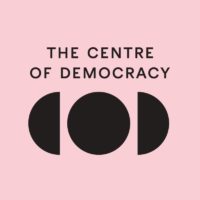On 29 April 1965 Prime Minister Robert Menzies announced that in response to a second request from the Government of South Vietnam, Australia would commit an infantry battalion for service. The decision was motivated by the belief that ‘the takeover of South Vietnam would be a direct military threat to Australia’ (Menzies, 1965:2), as well as by the desire to honor the alliance with the United States that had been formalised in the ANZUS Treaty 1951.[1] Five months earlier the Menzies Government had introduced the National Service Scheme which took effect in January 1965 and required men to register with the department of Labour and National Service on turning twenty.[2] Conscripts were selected from registrants by a lottery of birthdays held twice a year. Approximately one in twelve men registered was conscripted and required to serve two years in the army. Of those conscripted, about one in four was sent to Vietnam. The National Service Act 1964 stipulated that men who married before call-up, those in the Citizen Military Forces, and those with serious criminal records that made them a security threat could apply for indefinite deferment of their service, and that students, apprentices and trainees at universities, teachers’ colleges and technical colleges could apply for temporary deferment. The Scheme exempted those with physical and mental disabilities proscribed by legislation, theology students, ministers of religion, and members of religious orders. Under Section 29A of the Act individuals who were chosen in the ballot but whose conscientious beliefs did not allow them to engage in military service could also apply for exemption. They were, however, required to prove their beliefs to a court at their own expense.[3] Anyone who was required by the Act to register, but failed to do so, was automatically conscripted, and refusal to serve resulted in imprisonment.
Compulsory military service and Australia’s involvement in the war in Vietnam were highly contentious issues that led to the biggest demonstrations that Australia had ever seen. And as will become clear, between 1965-72 the meaning and status of protest itself was as much the subject of debate in Australia as the war in Vietnam and the nation’s role in it. Public opposition to the war and to conscription was apparent from the outset and took many and varied forms: as well the much-cited Moratorium marches there were sit-ins, pamphleteering, lectures, street theatre, vigils, petitions, work stoppages, teach-ins, public meetings, and more. The positions that individuals and groups expressed also varied greatly and were influenced by pacifism, libertarianism, maternalism, a range of understandings of democracy, and the discourse of revolution that was becoming increasingly popular internationally. Perhaps one of the most spectacular examples of protest took place in South Australia almost a year before the first Moratorium and made the front page of The News. Deploying a sort of agitprop approach associated with the increasingly radicalized New Left, Peter Hicks and a fellow Flinders University student alerted the media to their intention to publicly burn a dog (who, rather befittingly was named Plato) using napalm (or some substance of which it was a derivative). The aim of the stunt (which the pair had no intention of actually carrying out) was to incite outrage at the thought of such cruelty, and to thereby force people to reflect on the napalming of people, which was occurring on a daily basis in Vietnam, and which the public seemed largely unperturbed by. Hicks later described the event which, as planned, attracted much attention, as ‘a wonderful piece of street theatre because it really showed the double standards of those who supported the war’ (Hicks, 2007)
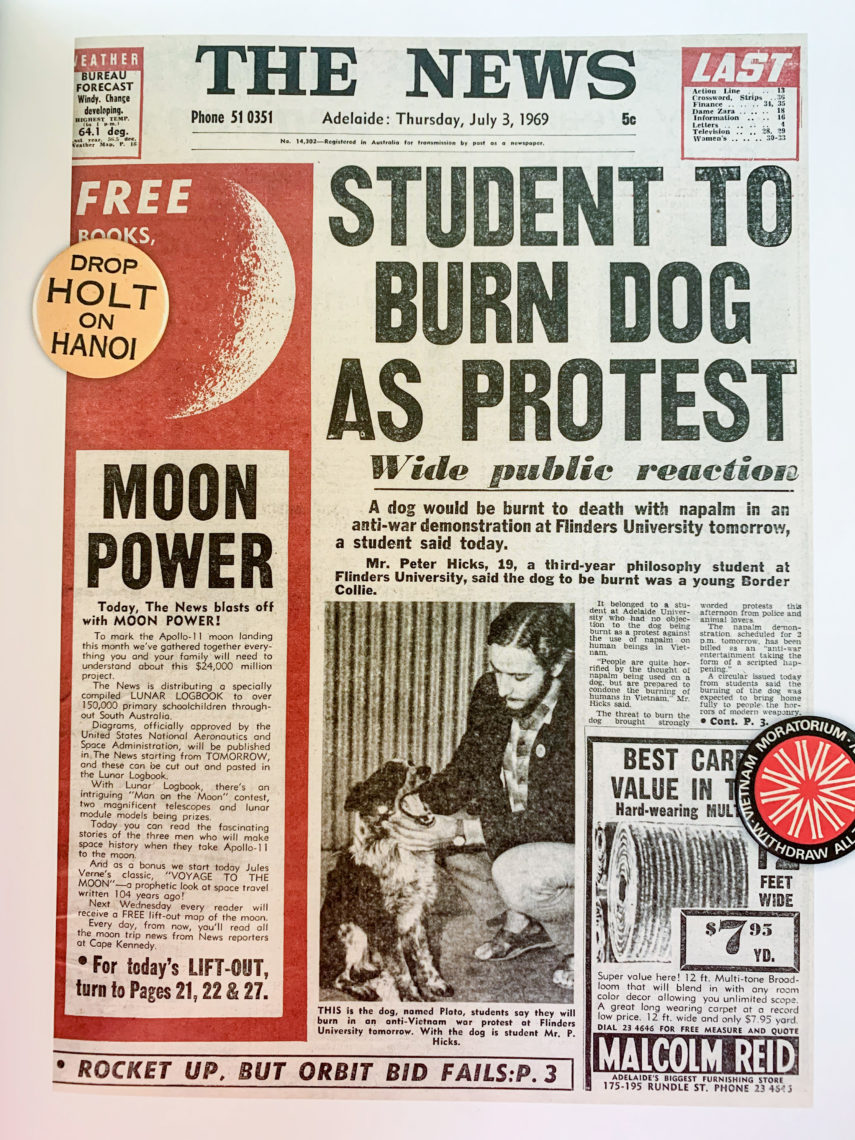
Rather than exploring events such as this in further detail, or attempting to provide an overview of the many activist groups and their responses to Australia’s role in the Vietnam War, the remainder of this article will focus on the Vietnam Moratoriums that took place in May and September 1970[4], the debates that surrounded and informed them, and their ongoing legacy. Specific attention will be given to South Australia.
How do you solve a problem like war/conscription?
As Brian Martin argues, ‘The “normal channels” of political action in a liberal democracy are those associated with the electoral system: voting, participating in political parties, lobbying and writing letters to politicians’ (1994:15). But what can or should citizens of a democracy do when the government (that they may or may not have voted for) makes decisions that will massively impact their lives, those of their loved ones, and the nation to which they belong, and with which they at best disagree and at worst find morally repugnant? The answer, in a word, is protest, and in this period protest was conceived by those who advocated it as public. One of the most outspoken and oft-quoted advocates of street protest was Labor politician and Federal MP, Jim Cairns.[5]
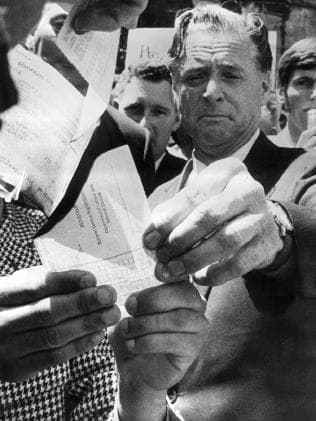
In the lead up to May 1970 Moratorium campaign[6] Cairns stated in a parliamentary debate that ‘Democracy is government by the people, and government by the people demands action by the people.[7] It demands effective ways of showing what the interests and needs of the people really are. It demands action in public places around the land’ (cited in Irving, 2015:276). Attorney-General Hughes disagreed, arguing that ‘[i]n a parliamentary democracy any attempt to change the law should be made within the framework of the law. Any other path to change is potentially anarchical’ (ibid.).[8] But, well aware of the Liberal Government’s position, Cairns had denounced this reasoning in a speech given two weeks earlier at Melbourne University. ‘The argument that things should be left to Parliament’ he proclaimed ‘is the argument of those who want to stultify and quieten the essentials of democratic action’ (ibid.).
Taking to the streets
Friday 8 and Saturday 9 May 1970 saw around 110,000 people march in (largely) peaceful protests against conscription and Australia’s involvement in the Vietnam War in towns and cities across Australia.[9] In Adelaide approximately 5,000 protestors marched from Elder Park, up King William Street to Victoria Square, where they listened to speeches from members of the Campaign for Peace in Vietnam, including Don Dunstan. In the period between the first and second Moratorium marches (May – September 1970) significant changes were taking place: in August Gallup polls suggested, for the first time, that a majority of Australians were against the war (Irving, 2015:283); then-Prime Minister John Gorton ‘acquiesced to demands by backbenchers to make ‘law and order’[10] a major political issue, announcing in August that a public order bill would be put before Parliament’ (Smith, 2016:96); increasingly radicalised sections of the protest movement were strongly advocating civil disobedience; and newspaper reports spoke less of democratic rights and more about the perceived threat of violence posed by the growing protest movement in Australia and further afield.
To cut a very long and complex story short, the lead up to the September campaign saw relations between organisers and police become increasingly fraught in most states. In South Australia plans for the main action which would take place on Friday 18September – a working day, and thus one in which the aim of severely disrupting business would best be achieved – included the occupation of a busy city intersection. While such an action was illegal, it was justifiable in the eyes of those who advocated it since it was not only a citizen’s right to break objectionable laws, it was, for some at least, a conscientious obligation.[11] Aware of demonstrators’ plans, Premier Don Dunstan requested that the Commissioner of Police allow protestors to illegally occupy the intersection without interference, that traffic be diverted, and that the police keep the peace, prevent any assault on protestors, and protect life and property.[12] The Commissioner rejected the Premier’s request. In a letter to Dunstan in which he outlined his position the Commissioner explained that while the protestors would be assisted in passing though the city freely, he could not condone the breech of the law that the occupation would incur since doing so would constitute a failure on behalf of the police to perform their duty of enforcing the law. Moreover, condoning the illegal occupation of a city intersection would, he feared, set a dangerous precedent: the police, he wrote, ‘could not deny another organization from doing the same thing at any other time for any other reason. Anyone might consider it a precedent for taking the law into their own hands by blocking a city intersection at any time’ (cited in Hart, 1970:56).
At 3pm between 4,000 – 8,000 protestors left Elder Park and proceeded to the intersection of North Terrace and King William Street where the march halted. Protestors formed a circle, in the middle of which street theatre performers entertained the crowd.
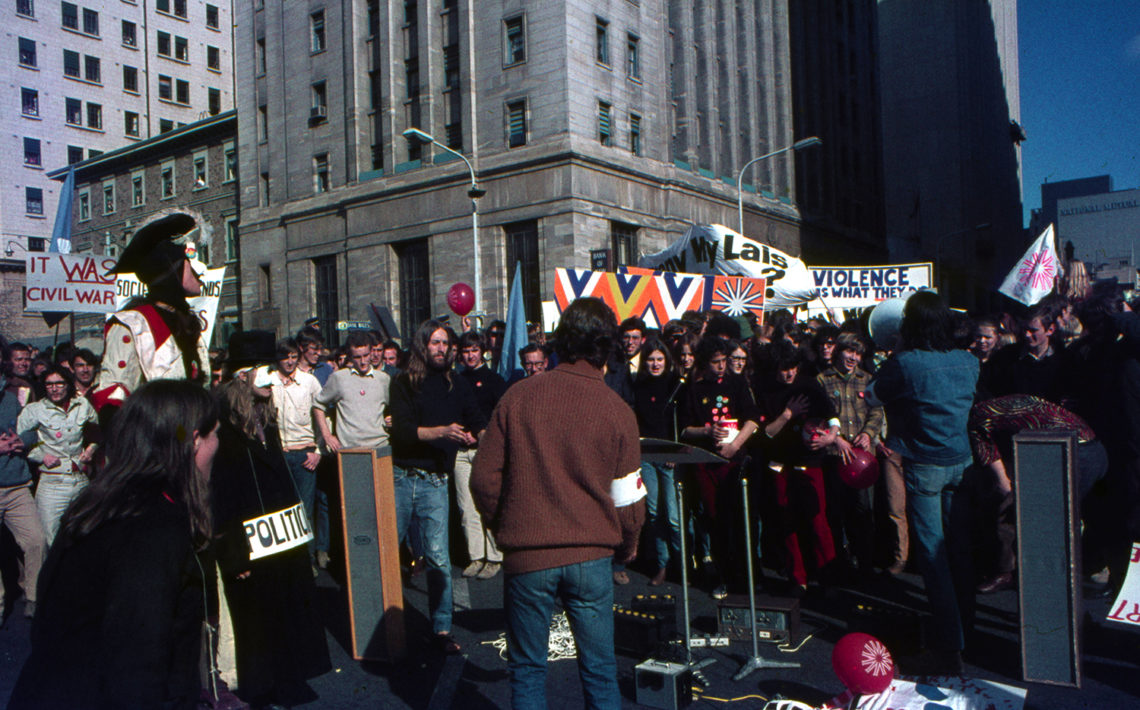
Under section 59 of the Police Offences Act 1953-1967 (SA) the police issued four warnings to disperse. Whether many of the protestors did not hear the warnings, or simply chose to ignore them is the stuff of debate, but over the next thirty minutes or so mounted and foot police moved in and arrested 130 people. Those who were not arrested, injured, or dissuaded from further action then gathered on the steps of Parliament House where they remained for several hours.
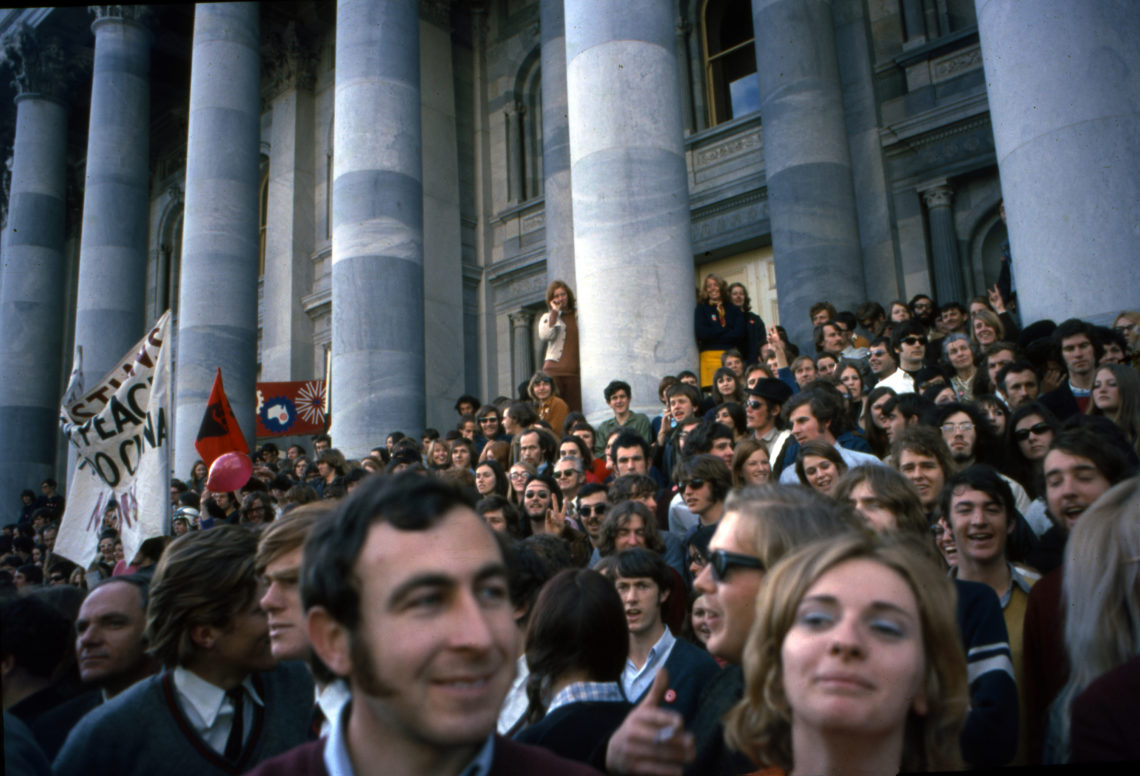
The events that unfolded resulted in the Governor-in-Council of South Australia, His Excellency Major General Sir James William Harrison, issuing a Royal Commission to Justice Bright the aim of which was to investigate what happened at the intersection and why, and how a repetition of public disorder in connection with public demonstration might, in future, be avoided. The investigation brought to the fore a number of interesting tensions. As Smith notes, at the heart of the protest and the police handling of it was a tension between the (alleged) rights of citizens of democratic states to ‘free association’ and, as Cairns and others advocated, to the conscientious breaking of objectionable laws, and the responsibility of said citizens to ‘remain peaceful and subject to laws made for the peace, order and good government of South Australia’ (1991:10). Interestingly, this tension prevails. The second point of contention on which Bright’s Report focused, and one which was, to some extent, resolved through the implementation of recommendations made, was the role and powers of the South Australian Police Commissioner. As Smith (1991) explains in his careful examination of the legal obligations of the Commissioner in September 1970, it was unclear how he could or should exercise the ‘discretionary powers’ bestowed upon him by the Governor, and what the relationship between his responsibilities as a public servant, his discretionary powers, and his answerability to an elected government (with its own far from impartial agenda). How could or should he use ‘reasoned discretion’ to satisfy the will of three masters – the public, the elected government, and the State as embodied in legislation when (as was the case in the situation surrounding the September Moratorium march) the will of all three was complex, contradictory and ultimately unreconcilable? While Premier Dunstan acknowledged that ‘the government had no power to legally direct the Commissioner in terms of the Police Regulation Act’, he reported to the Royal Commission that when, in the past, the government had issued directions to the Police Commissioner ‘he had always followed them and deferred to ministerial advisement’ (cited in Bright, 1970:58). Further, if the elected government is an expression of the will of the people, then should the Commissioner be obliged to follow ministerial advisement, even if doing so could be seen as ‘revoking the police oath to “prevent the commission of offences against the laws of the said state”’(Smith, 1991:12)? And what of the government’s obligation to support the police, in particular if it could be shown that their actions were guided by the laws of the state?
While hard and fast rules may not be applicable to these undoubtedly complex legal and moral questions, the discussion that the Royal Commission engendered led to legislative changes that continue to shape our experience of protest today. In 1972 S.21(1) of the Police Regulation Act (SA) 1952-1975 was amended to read as ‘subject to this Act and the directions of the Governor, the commissioner shall have control and management of the police force.’ And, as Smith suggests, and has proven to be the case in the three decades since his article was published, ‘Although not specified in the legislation, it is to be assumed that the Governor would take account of the wishes of parliament before endorsing any controversial act of the commissioner’ (1991:14).
Late 1970 saw the beginning of the two year-long withdrawal of Australian troops from Vietnam, and four days after the Whitlam-led Labor Party won the Federal election in December 1972 the last of the imprisoned draft resisters were freed. As Hamilton so succinctly puts it, ‘whatever the impact on the war, the massive Moratorium protests transformed Australian society’ (2016:30), furnishing us with many of the rights we now take for granted as well as with a language with which to claim them. Of course, change is never simply a matter of progress and rights gained at one moment in time are not guaranteed to continue in another. But when changes with which we disagree are implemented we do have histories on which we can draw, and this is undoubtedly one of them.
Protests for Peace: Photographs from the Adelaide Moratoriums
An exhibition of photographs by Leo Davis presented by The History Trust of South Australia and the Centre of Democracy from 2 November 2020 to 11 July 2021.
References
Hamilton, Clive (2016) What do we want? The Story of Protest in Australia, Canberra: NLA Publishing.
Bright, Charles Hart (1970) Royal Commission 1970 Report on the September Moratorium Demonstration, South Australian Blue Book, 1971-1972, Vol III
Hicks, Peter (2007) Oral history interview with Susan Mann, State Library of South Australia, J. D. Somerville Oral History Collection, OH836. https://archival.collections.slsa.sa.gov.au/oh/OH836.pdf
Irving, Nick (2015) ‘”Couldn’t we actually try and do this in Australia?”: Reading the Vietnam Moratorium in its Global Context,’ P. Deery & J. Kimber (eds.) Fighting Against War: Peace Activism in the Twentieth Century, Melbourne: Leftbank Press, pp. 268-90.
Irving, Nick (2017) Global Thought, Local Action: Australian Activism during the Vietnam War 1961-1972, unpublished PhD thesis, University of Sydney.
Martin, Brian (1994) ‘Protest in a Liberal Democracy,’ Philosophy and Social Action, 20:1-2, pp.13-24.
Menzies, Robert (1965) ‘Vietnam Ministerial Statement,’ Parliamentary Debates, https://pmtranscripts.pmc.gov.au/sites/default/files/original/00001105.pdf
Smith, Brian (1991) ‘Policy, Politics and Police Discretion’, Legislative Studies, 6:1, pp.9-15.
[1] Australia allegedly received a previous request in the first half of 1962 to which it responded by sending a group of 30 military instructors to provide military training assistance. This number was then doubled and later increased to one hundred. A flight of six Caribou transport aircraft was also provided (See Menzies, 1965, p.1).
[2] Not all men were required to register for national service: those who weren’t included Aboriginal men as defined by the National Service Act; members of the Permanent Armed Forces and former members who had served at least two years; United Nations staff; and, up until January 1967, non-British subjects.
[3] Opposition to the Vietnam War in particular was not sufficient to secure an exemption: applicants had to object to all war, to be a pacifist, and Nick Irving argues that pacifism was understood by authorities as inherently linked to religious beliefs – for example Quakerism. Irving also claims that
‘In all, 72% of the 1012 conscientious objection claims made between 1965 and 1971 were granted, and in total over 1200 young men were exempted as Conscientious Objectors during the life of the Scheme’ (2017:76-77).
[4] The nation-wide campaigns that composed the Australian Vietnam Moratorium occurred in March 1970, September 1970, and between April and June 1971. As Nick Irving has argued, the latter was less impactful than the first two and consequently has been given less scholarly attention. (Irving, 2017:124)
[5] Cairns, who was also chairman of the Victorian Moratorium Committee, was strongly opposed to the National Service Scheme which then-Opposition Leader Arthur Calwell referred to as the ‘Lottery of Death’, and in 1969 was arrested for distributing pamphlets that encouraged young men not to register for National Service.
[6] Plans for a Moratorium were discussed at a National Consultation held in Canberra on 25 November 1969, and subsequently branches of the Vietnam Moratorium Committee were established.
[7] For Irving ‘Cairns’ use of a phrase from the American Declaration of Independence – “government by the people” – hints at the ways in which American conceptions of democracy and citizenship inflect his thinking” (2015:277). This claim is part of Irving’s detailed thesis that the Moratorium Movement in Australia drew on, and should be understood in the context of, a ‘transnational vocabulary of protest’ (2015:269).
[8] On the day before the May Moratorium marches began Billy Snedden, ‘the Minister for Labour and National Service, described the organisers as ‘political bikies who pack-rape democracy’(cited in Hamilton, 2016:24). Four years earlier William McMahon, then- Minister for Labour and National Service had characterised protest organisers as a ‘people who [do] not believe in the ideals of Western democracy’ (cited in Irving, 2017:107).
[9] Estimates of numbers of people attended the marches in major cities, as well as nationally, do vary somewhat. This figure is from Irving (2017). While the marches were largely peaceful, a student-led march of around 2,000 people which took place on the evening of Friday 8 May resulted in a clash between protestors and young servicemen, and impacted the way in which future marches were viewed by police in South Australia. Brian Smith has also suggested that a protest which took place in Adelaide on 4 July 1969, and resulted in protestors throwing smoke bombs and stones at police, shaped the way in the later protests were handled by the South Australian police (1991:10).
[10] Gough Whitlam described ‘law and order’ as ‘an inflammatory issue to take the minds of the Australian people from the real issues facing the nation’ (cited in Irving, 2015:283). For a detailed discussion of ‘law and order’ see also Smith (2016).
[11] For a detailed discussion of the notion of conscientious law breaking, and, more specifically, Jim Cairns deployment of it, see Irving (2015).
[12] Summarised in the Royal Commission 1970 Report on the September Moratorium Demonstration, p.56.

